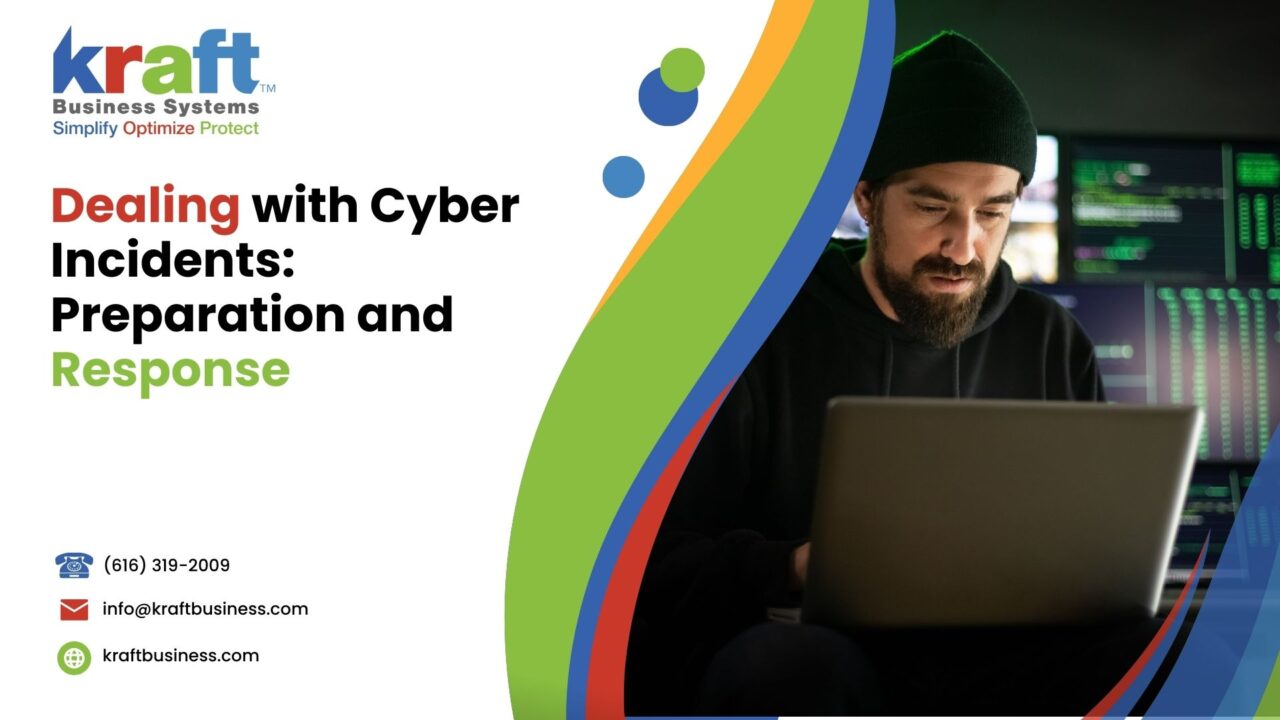Cyber incidents refer to events that compromise the integrity, confidentiality, or availability of information systems. These incidents can range from data breaches and ransomware attacks to phishing scams and DDoS attacks.
Over the past few years, the frequency and sophistication of cyber incidents have increased significantly, with 2022 and 2023 witnessing some of the most impactful cyber attacks in history. These incidents not only disrupt business operations but also lead to substantial financial losses and damage to reputation. The introduction of cybersecurity incident management is crucial to mitigate these effects and ensure swift recovery.

Dealing with Cyber Incidents: Strategies and Best Practices
Understanding Cyber Incidents
What is a Cyber Incident?
A cyber incident is any event that threatens the integrity, confidentiality, or availability of information systems. These incidents can be caused by external attackers, internal threats, or accidental actions. Common types of cyber incidents include data breaches, where unauthorized individuals gain access to sensitive information; ransomware attacks, where malicious actors encrypt data and demand a ransom for its release; phishing attacks, where attackers deceive individuals into providing personal information; and DDoS attacks, where systems are overwhelmed with traffic to disrupt service.
Key Terms and Concepts
Understanding key terms and concepts is essential in the context of cyber incidents. Cybersecurity involves protecting systems, networks, and data from cyber attacks. A cyber attack is any attempt to gain unauthorized access to a system or disrupt its operations. A data breach occurs when sensitive information is accessed without authorization. Vulnerabilities are weaknesses in a system that can be exploited by attackers. Malware is malicious software designed to harm or exploit systems.
Exploits are methods used to take advantage of vulnerabilities. Phishing is a technique used to trick individuals into revealing personal information. Ransomware is a type of malware that encrypts data and demands a ransom for its release.
Dealing with Cyber Incidents: Strategies and Best Practices
Causes and Methods of Cyber Attacks
Common Causes of Cyber Incidents
Cyber incidents are often caused by social engineering, phishing, and spear-phishing attacks. Social engineering involves manipulating individuals into divulging confidential information. Phishing is a method where attackers send fraudulent emails to trick recipients into providing sensitive data.
Spear-phishing is a more targeted form of phishing, aimed at specific individuals or organizations. Another common cause is the exploitation of vulnerabilities in software. For instance, unpatched security flaws in Microsoft software have been frequently targeted by hackers.
Techniques Used by Hackers
Hackers employ various techniques to carry out cyber attacks. Malware and malicious code are commonly used to infiltrate systems and steal data. Ransomware, a form of malware, encrypts data and demands a ransom for its release, causing significant disruption to businesses.
Social engineering techniques, such as phishing and spear-phishing, deceive individuals into providing access to sensitive information. Hackers may also use backdoors to gain unauthorized access to systems. These backdoors allow them to bypass normal authentication processes and gain control over systems without being detected.
Dealing with Cyber Incidents: Strategies and Best Practices
Impact of Cyber Incidents
Consequences for Organizations
Cyber incidents have severe consequences for organizations. Financial losses are one of the most immediate impacts, often due to ransom payments, legal fees, and lost business opportunities. For example, a ransomware attack can result in substantial costs for decryption or data recovery. Damage to reputation and customer trust is another critical consequence.
Customers are less likely to do business with organizations that have suffered data breaches. Operational disruption and downtime caused by cyber incidents can halt business operations, leading to further financial losses.
Consequences for Individuals
Individuals affected by cyber incidents may suffer significant consequences, including the loss of personal information and privacy. Data breaches can expose sensitive information such as social security numbers, credit card details, and medical records.
Identity theft is a common result, where attackers use stolen information to impersonate victims and commit fraud. Financial fraud, where attackers make unauthorized transactions using stolen information, can lead to substantial financial losses for individuals.
National and Economic Security Implications
Cyber incidents also have broader implications for national and economic security. Attacks on critical infrastructure, such as power grids, water supply systems, and transportation networks, can disrupt essential services and threaten public safety. Cyber incidents targeting financial institutions can destabilize the economy.
For example, a major cyber attack on a national bank could lead to a loss of confidence in the financial system. Public health and safety are also at risk if cyber incidents target healthcare systems, potentially disrupting medical services and endangering lives.
Dealing with Cyber Incidents: Strategies and Best Practices
Cybersecurity Measures and Best Practices

Preventive Measures
Preventing cyber incidents requires a multi-faceted approach. Implementing robust security policies and procedures is crucial. Organizations should conduct regular vulnerability assessments and penetration testing to identify and mitigate potential security weaknesses. Keeping software and systems updated with the latest security patches is essential to protect against known vulnerabilities.
Technical Solutions
Technical solutions play a vital role in cybersecurity. Firewalls, antivirus software, and anti-malware tools are fundamental components of a strong security posture. Multi-factor authentication (MFA) adds an extra layer of security by requiring users to provide multiple forms of verification before accessing systems. Strong passwords, combined with password management practices, help protect against unauthorized access.
Training and Awareness
Human error is often a significant factor in cyber incidents. Therefore, training and awareness are critical components of a cybersecurity strategy. Employees should be trained to recognize phishing attempts and other social engineering techniques.
Best practices for sharing sensitive information should be emphasized, including the use of secure communication channels and the avoidance of public Wi-Fi networks for sensitive transactions.
Dealing with Cyber Incidents: Strategies and Best Practices
Incident Response Plan
Importance of an Incident Response Plan
An incident response plan is essential for any organization to mitigate the damage caused by cyber incidents and ensure a swift recovery. Having a well-structured plan allows organizations to respond promptly and effectively to security breaches, minimizing the impact on operations, finances, and reputation.
It provides a clear framework for identifying, managing, and resolving cyber incidents, ensuring that all necessary steps are taken to protect sensitive information and restore normalcy as quickly as possible. Additionally, an incident response plan helps organizations comply with legal and regulatory requirements by outlining procedures for reporting and documentation.
Components of an Incident Response Plan
A comprehensive incident response plan consists of several critical components.
First, the plan should include the identification and classification of incidents to determine their severity and potential impact. This involves establishing criteria for categorizing incidents based on factors such as the type of data compromised, the number of affected systems, and the potential harm to individuals or the organization.
Second, the plan must clearly define the roles and responsibilities within the response team. Each team member should have a specific role, whether it’s technical analysis, communication, or coordination with external entities.
Third, the plan should outline communication protocols to ensure timely and accurate information sharing among team members, stakeholders, and external parties, including law enforcement and regulatory agencies.
Incident Response Phases
The incident response process is typically divided into several phases. The preparation phase involves establishing and maintaining the incident response plan, training staff, and conducting regular drills to ensure readiness. During the detection and analysis phase, organizations monitor their systems for signs of potential incidents and perform initial assessments to determine the scope and nature of the threat.
The containment, eradication, and recovery phase focuses on isolating affected systems to prevent further damage, removing malicious code or access points, and restoring normal operations.
Finally, the post-incident review and improvement phase involves analyzing the incident to identify lessons learned, improve response strategies, and update the incident response plan as needed.
Dealing with Cyber Incidents: Strategies and Best Practices
Reporting and Legal Considerations
Reporting Cyber Incidents
Timely and accurate reporting of cyber incidents is crucial for mitigating damage and fulfilling legal obligations. Organizations should establish clear guidelines for when and how to report incidents, both internally and to external entities. Internal reporting involves notifying the appropriate personnel within the organization, such as the incident response team and senior management. External reporting may be required by law or regulation and typically involves notifying law enforcement agencies, regulatory bodies, and affected individuals.
Dealing with Cyber Incidents: Strategies and Best Practices
Future Trends in Cybersecurity
Emerging Cyber Threats
The cybersecurity landscape is constantly evolving, with new threats emerging regularly. Organizations must stay informed about these trends to protect themselves effectively. One notable trend is the increasing sophistication of cyber attacks, with attackers using advanced techniques such as artificial intelligence and machine learning to evade detection.
Another emerging threat is the rise of supply chain attacks, where cyber criminals target third-party vendors to gain access to larger organizations. Additionally, the proliferation of Internet of Things (IoT) devices has introduced new vulnerabilities, as these devices often lack robust security measures.
Advancements in Cybersecurity
To combat emerging threats, advancements in cybersecurity technologies and practices are essential. Innovative security technologies, such as AI-driven threat detection and response systems, can help organizations identify and mitigate threats more effectively. The use of blockchain technology for secure transactions and data integrity is another promising development.

Furthermore, the adoption of zero-trust architecture, which assumes that threats can exist both inside and outside the network, is gaining traction. This approach involves strict verification of all users and devices attempting to access resources, reducing the risk of unauthorized access.
Dealing with Cyber Incidents: Strategies and Best Practices
What People May Also Ask
What should I do if I suffer a cyber attack?
What should I do if I suffer a cyber attack?
If you suffer a cyber attack, the first step is to remain calm and follow your organization's incident response plan. Immediately disconnect affected systems from the network to prevent further damage. Notify your incident response team and relevant authorities.
How can I improve the security of my organization?
Improving your organization's security involves implementing a multi-layered approach. Regularly update and patch software to address vulnerabilities. Use strong passwords and multi-factor authentication (MFA). Conduct regular security training for employees to raise awareness about common threats.
What are the common signs of a cyber incident?
Common signs of a cyber incident include unusual system behavior, such as slow performance or unexpected crashes. You may notice unauthorized access attempts, changes to system configurations, or the presence of unfamiliar files or programs.
What are the best practices to prevent cyber incidents?
Preventing cyber incidents involves implementing several best practices. Regularly update and patch all software and systems to address vulnerabilities. Use strong, unique passwords and enable multi-factor authentication (MFA). Conduct regular security training for employees to raise awareness about common threats and safe online practices.
What are the legal requirements for reporting a data breach?
Legal requirements for reporting a data breach vary by jurisdiction. In general, organizations must notify affected individuals and relevant authorities within a specified timeframe after discovering a breach.
Dealing with Cyber Incidents: Strategies and Best Practices
Conclusion
In conclusion, cyber incidents pose significant threats to organizations and individuals alike. By understanding the nature of these incidents, implementing robust cybersecurity measures, and developing an effective incident response plan, organizations can mitigate the impact of cyber attacks and ensure swift recovery.
Staying informed about emerging threats and advancements in cybersecurity is crucial for maintaining a strong security posture. Proactive measures, combined with a culture of security awareness, can help protect sensitive information and maintain trust with stakeholders.






